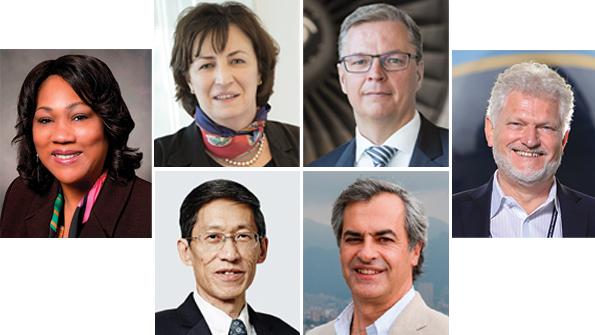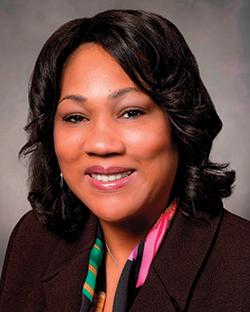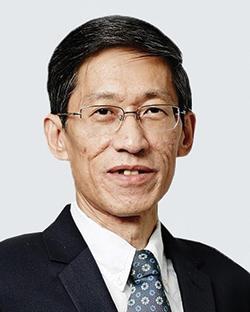
Aviation Week launched the first MRO event in 1996, which also launched the term “MRO.” To celebrate 25 years of the industry, Inside MRO reached out to some executives around the world to get their opinions on a few key questions about how the industry has evolved—and how it most likely will change in the decades to come.

JOAN ROBINSON-BERRY
Vice president and chief engineer, Boeing Global Services
Over your career, what do you think had the biggest impact on MRO and why?
Looking back, I can’t say there is a single “biggest impact” area but rather intertwined challenges, opportunities and observations that have shaped where MRO is today. And with thoughtful consideration, these learnings can help create an MRO evolution in the aerospace sector.
Boeing Global Services provides technical solutions for our commercial and government customers around the world. And we’ve been able to deliver on these by attracting and retaining a diverse, motivated workforce. But it hasn’t always been easy, with MRO activities moving from paper records to digital solutions. It can be a challenge to find maintenance technicians with top-secret clearances and software engineers and aviation data scientists who have the critical thinking skills needed to perform with precision. This is why apprenticeship programs and internships that deliver hands-on career preparation are so important—they enable and help build a skilled workforce with top talent.
Another area that has impacted—and will continue to impact—the MRO services market is the ability to be more integrated and standardized, so that the value chain can deliver day in and day out for our customers. It’s not an “us” or “them” mentality but a “we,” and by having standards and common protocols in place, we have the opportunity to deliver improved operational efficiency for every single customer around the world. We can help connect the dots between OEMs, suppliers and MRO providers in such a way that the industry is better trained and aligned for improved quality and outcomes.
The manufacturing industry has also had an impact on MROs, particularly when needing access to a robust parts supply for older aircraft. Maintainers can’t do their job if they don’t have access to a seamless parts supply. It’s about having the right part at the right time and in the right place. That’s where advancements with additive manufacturing or innovative programs such as Boeing’s used serviceable materials program can drive efficiencies and value for the aviation industry.
The MRO market has evolved and will continue to evolve as the industry accepts new innovations, advances technical solutions, partners for standardization and invests in training a skilled workforce.

ANNE BRACHET
Executive vice president, AFI KLM E&M
What is the biggest current challenge the MRO industry is facing?
The current circumstances are exceptional and have resulted in greater levels of unpredictability. Adaptiveness is part of our DNA. More than ever, during this coronavirus situation our teams are mobilized to support our customers as well as possible while following local government restrictions. They will be ready and engaged for a restart, whatever the time necessary for a new “takeoff” of the economy, but the situation is too fluid and uncertain to have a clear vision of the future.
The only certainty in a changing world, as we see it, is that innovation and adaptation will drive the business.
Environmental consideration issues will likely be one of the major challenges for players in the MRO market. Airlines around the world are challenged regarding the impact of their operations on the environment, and maintenance activities must play a role and take their full place in meeting this challenge. This is not a new issue for AFI KLM E&M, as we are already well-advanced in terms of circular economy or the reduction of polluting emissions, but this trend will accelerate over the next 10 years, and that will give us another opportunity to positively meet the times.
What do you see as the biggest opportunities and/or largest impediments in using data analytics to drive predictive maintenance?
In the digital field, Prognos is an important brick. Launched in 2016, it brings together different predictive maintenance solutions based on the exploitation of data from aircraft systems, in order to improve maintenance models and processes. We capitalize on the vast amount of data generated by the Air France and KLM fleets to develop these solutions and verify their relevance and operational performance before sharing these innovations with our customers.
For an airline, operational performance is a major challenge in terms of both economy and safety. Today, the use of data provided by the aircraft makes it possible to reduce the number of technical delays, reduce the number of technical tolerances and anticipate the interventions of maintenance personnel on the aircraft before equipment fails. We have several hundreds of aircraft that are tracked, and we reduce the technical effects felt by at least 50%. We are thus able to anticipate the arrival of a technical failure and reduce the volume of failures by 50-70%. Leveraging our in-depth knowledge of aircraft systems, our ability to innovate and our big data skills, we are able to reduce operational impacts and the aircraft dispatch.
The main beneficiaries of this new branch of maintenance activities are passengers.
Predictive maintenance also has an impact on the supply chain and stock dimensioning. Because we can predict the needs of components, we can adjust the number of parts and where it is valuable to place them.
As another benefit, by reducing stock, repairing instead of replacing and reducing fuel consumption, big data technologies help reduce the environmental impact of the aeronautic industry. That’s why, in 2019, Prognos was identified and certified as an environmentally efficient solution by the Solar Impulse Foundation.

Johannes Bussmann
CEO, Lufthansa Technik
What do you see as the biggest opportunities and/or largest impediments in using data analytics to drive predictive maintenance?
Ideally, predictive solutions will reduce the overall cost of operation, reduce operational interruptions and increase the reliability of the fleet. The number of airlines using the latest big data solutions is limited but growing quickly. Many airlines worldwide are looking at such solutions, but the products of real predictive maintenance are limited. Many products are just providing digital results without a direct connection to maintenance actions.
Therefore, Aviatar, our digital operations suite, can be directly and automatically linked to fulfillment actions. We are working closely with different maintenance and engineering system vendors such as AMOS or TRAX and other airline information technology providers such as NetLine to make our platform plug-and-play for operators. Aviatar’s digital solutions can also be connected to any other data source, not just aircraft data.
However, big data is not an advantage by itself, and there are no “automatic” analytics. It is important to understand that “it is not the amount of data; it is the right amount of the right data” that makes the difference. It is about combining the data with the technical and operational experience of the engineering experts, both in the airline and the MRO organization, to deliver the best results. Prediction is nothing without fulfillment.
Data control is a key issue, because more and more OEMs restrict access to operational data for airlines that own the data. This reduces the choices for airlines to cooperate with MROs and other players in the market. I think we are not the only ones in this industry to say that this is not acceptable. Other impediments can be a lack of sensors or equipment on older aircraft. Also, on the newest aircraft, sensors on components sometimes cannot transmit in real time for reasons such as data links and/or other limitations, which do not allow it to be combined with other operational data.
The lack or the cost of connectivity, as well as limited data science experience/resources, or missing infrastructure and interfaces between the various data sources within an airline, limit the use of predictive technologies. Human factors, pilot unions and legal obstacles can also be impeding factors. In addition, internal stakeholders such as work councils may restrict the use of new digital technologies or the linking of certain data sources.
How do you think the MRO industry will evolve over the next 10 years?
Despite the current negative impact of the coronavirus on the global aviation business, I am sure that the aviation industry will remain on a solid growth path in the midterm and long term. Consequently, the MRO market will also continue to grow.
I am also sure that digitization and automation will become increasingly important for us and will lead to a significant change in how MRO services will be executed in the future.
Higher degrees of automation will have entered certain repair processes, from paperless maintenance and new diagnostic tools to robotics. All these aspects will not replace our highly qualified employees but will relieve them of the burden of many dull and repetitive tasks so that they can fully concentrate on the real value-adding jobs. Mobile applications will also play a major role in my vision of MRO 2030, but the information technology infrastructure will have to evolve for that to happen. For example, we are already pioneering in the field of 5G networks with two different use cases at our Hamburg base.
Moreover, I see our industry making significant progress in the next decade through the knowledge of collecting, analyzing and using large volumes of data. Building capacities in data sciences will help us leverage the full potential of predictive and proactive maintenance. Modern aircraft already produce this enormous amount of data, and by 2030 we will have greatly improved our knowledge on how to make use of it.
During your career, what do you think had the biggest impact on MRO and why?
I have been working in the MRO industry for more than 20 years now, but I think the event with the biggest impact took place not too long ago with the advent of digitization in our industry. Although we are only at the beginning of this process, it has already opened up so many new possibilities to rethink what we do and how we create value for our customers.
At Lufthansa Technik, this is happening in three dimensions: The first is the digitization of our core business, meaning that we will not change the existing work steps fundamentally but improve them step by step by implementing more digital aids.
The second dimension is the digital evolution of our existing products and services. In the future, we want to make digital solutions that were previously not possible, but we do not want to change the respective business model behind them. This is exactly the case in the field of predictive maintenance: The evaluation of aircraft, engine or component data will allow us to track and monitor their condition in real time. The fulfillment—for example, the rectification of any damage—remains the same but will now take place exactly when it is necessary, not too early, not too late.
The third dimension—which, for me, will be the truly disruptive step—is the creation of a digital business model or a new digital ecosystem where our customers can display their entire fleet as a digital twin, providing an overview of the condition of each aircraft at all times. The impact of such developments will surpass anything previously seen.

Lim Serh Ghee
President of ST Engineering’s aerospace sector
What is the biggest current challenge the MRO industry is facing?
The biggest challenge now may well be COVID-19, with impacts arising from customer demand reduction, the supply chain and workforce redistribution. However, the aviation industry has shown itself to be resilient—for instance, during the SARS outbreak in 2002—and should be able to rebound strongly.
The other challenge, which is becoming increasingly pressing, is the global shortage of aircraft technicians. The shortage will only be further compounded, even if just for a period, when manpower resources are pulled to return all the grounded Boeing 737 MAXs into service. The positive side to this is that it will serve to fuel the already accelerating adoption of technologies by the industry to optimize maintenance.
What do you see as your biggest opportunity in the next five years, and how do you plan to capitalize on it?
The OEM business is something we have been investing in and which we believe will allow us to capture significant synergies when integrated with our MRO business. In a market that is getting more fragmented, the breadth and depth in the value proposition we can offer as both an OEM and MRO service provider will help set us apart from our competitors.
What do you see as the biggest opportunities and/or largest impediments in using data analytics to drive predictive maintenance?
Manpower shortages, an increasing focus on sustainability and keen competition among airlines will be some of the key factors driving advances in predictive maintenance.
However, near-term implementation may not be as straightforward. Existing restrictions in access and rights to data controlled by various stakeholders mean that MRO service providers have to deal with imperfect and incomplete data most of the time. The aviation industry would benefit as a whole if we had an open-source environment akin to the software industry and in how applications are being developed.
How do you think the MRO industry will evolve over the next 10 years?
I believe sustainability will become one of the key focuses for the industry in the near-to-midterm. As it is, the global air transport industry has begun to take its environmental responsibility more seriously.
And as part of striving to become more sustainable in the business sense, I believe the industry will also step up its efforts in automating operations and using data analytics to reduce, reuse, recycle and recover.
Over your career, what do you think had the biggest impact on MRO and why?
The growth of the global aircraft fleet, which is especially strong in Asia-Pacific in recent years, and enlightenment among carriers to outsource their maintenance needs over the past two decades are some of the key trends I have seen affecting the industry. Such trends have a direct impact on the growth of the MRO industry and also on the level of competitiveness one now sees.

NORBERT MARX
CEO and general manager, Gameco
What is the biggest current challenge the MRO industry is facing?
Without a doubt the biggest and most urgent challenge we are fighting right now is how to deal with the COVID-19 situation. Gameco was hit hard already at the end of January, right during the peak travel season in China. Very quickly we established a program focusing on three main issues: how to keep our employees healthy, how to ensure aviation safety under these circumstances and how to keep the company stable, especially financially.
We have established a whole series of actions. Just to mention a few: This is a stressful and worrisome time, so to address human factors we established a hotline for psychological support and guidance for our mechanics or staff under quarantine. We split teams for social distancing or to prevent grounding of a whole team in case of an infection. Of course, special attention needs to be paid to the handover of work. Our line maintenance business is hit hardest, but we tried to rebalance the workload by pulling checks and modifications forward on grounded aircraft. We expect domestic flights in China will start to pick up again in April.
What do you see as your biggest opportunity in the next five years, and how do you plan to capitalize on it?
Gameco and China Telecom cooperated on the application of 5G technologies in 2019. Meanwhile, all our hangars and facilities are fully equipped with 5G infrastructure. Now our customers can perform remote quality inspections from their home office, or our engineering team can give onsite support to our mechanics with augmented reality equipment. We accelerated the use of this equipment due to the coronavirus pandemic, and it allows us to establish a 3D-cloud of virtual data points all over our facilities.
These 5G applications then can track, coordinate and address every aircraft, tool, working platform and piece of equipment within this cloud. Via face recognition, mechanics can be linked to tasks, performance of work can be coordinated and optimized, and material ordering and delivery can be handled with some clicks from a smartphone right at the point of work. The potential is huge over the next couple of years, and our team is very excited about the opportunities.

Jose Luis Quiros
Senior vice president of maintenance and engineering, Avianca
What is the biggest current challenge the MRO industry is facing?
There is definitely not one single challenge, and most of those that exist are not really new and will not disappear in the next few years: capacity, efficiency, flexibility, globalization and “customer satisfaction.” But there is one affecting our whole society and MRO: the next steps in digital transformation.
After some years in which data acquisition, massive storage and accessibility have been problems, what we do with them and how we use them will become wide territory to be discovered, framed with the unsolved questions about who is really proprietor of the data and how the associated rights are protected.
Before, the important thing was to use data better to find solutions to problems already identified. Now, the issue is how we should change the way in which activity in MRO is executed based on a significantly different scenario, where data tends to no longer be a problem and the ability to draw information from it is extraordinarily higher than in previous decades.
Artificial intelligence (AI) is definitely shaping the business landscape, but it is not clear how. There has been a lot of hype about AI, and according to different market studies, demand for workers with AI skills has experienced steady growth over the past few years. When you add that there’s currently a shortage of job seekers who can meet that need, it only makes the skills more valuable for those who do possess them or would like to learn. It will be necessary to carefully define the kind of jobs that are being created specifically. And now that AI is becoming a reality, there is an urgent need to understand how it is really affecting the learning and working environment.
What do you see as your biggest opportunity in the next five years, and how do you plan to capitalize on it?
MRO will develop in the Latin Ameri can region in the coming five years. Although it is exposed to a certain level of instability, like almost all other regions of the world, from the social, political and economic fronts, it will facilitate the required level of investment. The necessary workforce is available with the required technical skills and competitive costs, with excellent “soft skills” in terms of age, use of technologies, “digital mind setup,” etc.
The combination of the aforementioned elements makes Latin America a fertile region, with a privileged geographical location, not only to satisfy its needs up to a much higher percentage, but also to attract business from nearby markets that started to have a hard time finding maintenance slots in the Asia-Pacific region.
What do you see as the biggest opportunities and/or largest impediments in using data analytics to drive predictive maintenance?
Predictive maintenance is obviously one of the low fruits of the digitization of our working environment, since the “intelligent” use of the large amount of data available, the relatively easy build-up of operational systems and failure mode patterns, and accessibility should allow this concept to become one of the most successful tools in our activity.
Nevertheless, there are some aspects around preventive maintenance that, in my opinion, are not helping to develop the concept to its optimal stage: It is not clear there is full alignment between service/platform providers and users in terms of what the final goals of predictive maintenance will be, and there is no proper balance between standardization and competition in terms of variety of available solutions.
With a much broader common ground among the industry players about what is really required and a clear set of minimum standards to be applied to the different solutions, we should be able to get better predictive maintenance tools.
How do you think the MRO industry will evolve over the next 10 years?
In the first place, evidently air transport growth and fleet evolution will set the frame for the MRO industry in terms of capacity and—such as whether MRO centers could do something additional to MRO—as an option for the coming 10 years, and therefore the drivers will be the same we have today.
On the other hand, the trend of consolidated OEMs getting a bigger portion of the MRO business (the OEMRO concept) will be even more deeply implemented, although I still see a question mark regarding whether or not airframe activity will be finally affected by this model, even with a limited scope (modifications, end-of-lease transitions, etc.)
I think we will see a significant change in the profiles of MRO technicians and engineers, not so much because of the changes in the professional skills (basically educational) but as a consequence of the faster evolution (revolution in some cases) of our society from many points of view and the impact on its members. This is not new, and it has been a constant for decades, but the depth and the speed of the changes are probably higher and will have a more visible effect on the MRO model.
It is important to confirm in the coming years whether diversity and inclusion will be competitive advantages or myths. The world is different from what it was 20 years ago and will change even faster in the coming years. The workplace, workforce and marketplace are changing in ways that require a different approach to management. Less than 5% of management roles are currently filled by women, and the inequality today is quite palpable.
And, finally, environmental care and sustainability will undoubtedly be considered a top priority when defining or reviewing repair and maintenance processes, and of course in designing and rebuilding facilities, not only to comply with regulations, but as a result of the companies’ vision and social responsibility commitments.
